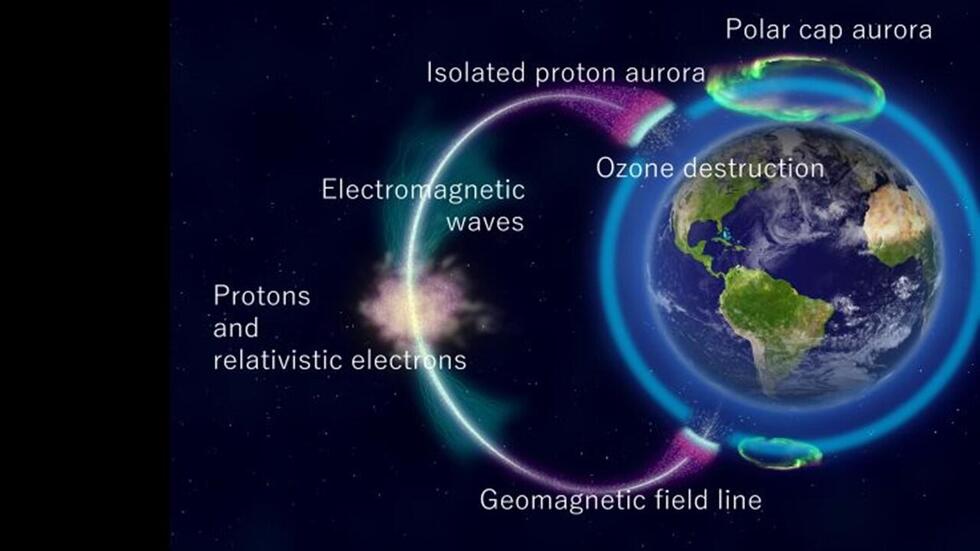
Mathematical and physical sciences
October 12, 2022
Researchers use aurora to reveal changes to ozone layer caused by charged particles in space
To assess changes caused to the ozone in Earth’s mesosphere (50-80 km altitude) by charged particles in space that surround the Earth, an international team of researchers from Japan, the United States, and Canada studied a type of aurora called an “isolated proton aurora”. They found more changes than predicted by simulations, suggesting a new factor to consider when assessing changes to the ozone at these altitudes.
Along with solar radiation from the Sun, cosmic rays, and high-energy plasma particles, such as ions and electrons, bombard the Earth's atmosphere. Among these particles, electrons in the radiation belt, the layer that surrounds the Earth in space, may fall along magnetic field lines into the Earth's atmosphere. When they fall, their charge ionizes the atmosphere and produces nitrogen oxides and hydrogen oxides. Both compounds contribute to ozone loss, particularly in the Earth’s mesosphere, which is the region above the stratosphere where the critical life-protecting ozone layer resides.
Although high-energy plasma particles may change the amount of ozone in the mesosphere, details of their impact are less well understood. This is because such particles are not visually observable, making it difficult to ascertain their location. However, when these charged particles interact with the upper atmosphere, they emit an isolated proton aurora that falls toward Earth. Normally, auroras appear as a belt around the north and south poles, however, these isolated proton auroras are visible as isolated spots or bands at lower latitudes.
Researchers from Nagoya University, Kanazawa University, and the National Institute of Polar Research in Japan; Johns Hopkins University in the USA; Athabasca University and the University of Alberta in Canada; NASA Langley Research Center; and the Japan Aerospace Exploration Agency (JAXA) investigated the ozone fluctuations below the isolated proton aurora to assess the impact of radiation-belt electrons. They reported their findings in Scientific Reports.
To detect electrons over the aurora, the team used a combination of satellite remote sensing, ground-based electromagnetic wave observations, and information from the International Space Station. For the first time, the data revealed the formation of a localized ozone hole in the mesosphere, about 400 km wide, which was associated with isolated proton auroras. While decreased ozone was observed, this phenomenon should have no effect on the stratospheric ozone layer that protects life on Earth.
Comparing their results to simulations, the researchers found that the change was much greater than predicted. Up to 10-60% of the ozone directly below the aurora was destroyed 90 minutes after it began. However, the researchers stress that this change is expected to heal naturally and cause no long-term decline in the ozone in the mesosphere. Since the localized changes were directly below the isolated proton aurora, the researchers compared it to a pinpoint hole in a shoji, the paper sliding doors found in traditional Japanese houses.
“Researchers from a wide range of research fields related to plasma physics, aurora science, trace atmospheric composition sensing, and electromagnetic wave engineering were brought together to achieve comprehensive observations through international cooperation,” explains team member Kazuo Shiokawa, a professor at the Institute for Space-Earth Environmental Research at Nagoya University. However, he points out that even those without sophisticated technology can see isolated proton auroras. “Isolated proton auroras can be observed by scientific all-sky cameras,” he said. “Although it is a rather weak aurora, it is also visible to a regular person.”
“This is the first observational study in the world to show that radiation belt electron fallout from space around the Earth has a direct, immediate, and localized effect on atmospheric changes in the mesosphere,” the researchers said. “This study revealed that radiation belt electrons falling into the atmosphere from space around the Earth have a rapid and localized effect on the composition of the microatmosphere, including ozone. This finding is expected to contribute to an improved prediction of short-term changes in the Earth's atmospheric environment by considering the effects of atmospheric ionization by high-energy plasma from space.”
“This result strongly suggests that the influence of radiation belt electrons cannot be ignored in predicting changes in the Earth's atmospheric environment,” they concluded.
For the first time, researchers revealed the formation of a localized ozone depletion
associated with “isolated proton aurora.” (Credit: Kanazawa University)
The study, "Localized mesospheric ozone destruction corresponding to isolated proton aurora coming from Earth's radiation belt," was published in Scientific Reports on October 11, 2022 at https://www.nature.com/articles/s41598-022-20548-2.
Authors:
Mitsunori Ozaki, Kazuo Shiokawa, Ryuho Kataoka, Martin Mlynczak, Larry Paxton, Martin Connors, Satoshi Yagitani, Shion Hashimoto, Yuichi Otsuka, Satoshi Nakahira, and Ian Mann
This work was supported by Grant-in-Aid for Scientific Research (JP16H06286, JP20H02162) from Japan Society for the Promotion of Science.
Media Contact:
Matthew Coslett
International Communications Office, Nagoya University
kouho-en@adm.nagoya-u.ac.jp